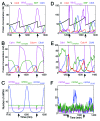Measurement and modeling of transcriptional noise in the cell cycle regulatory network
- PMID: 24013422
- PMCID: PMC3865016
- DOI: 10.4161/cc.26257
Measurement and modeling of transcriptional noise in the cell cycle regulatory network
Abstract
Fifty years of genetic and molecular experiments have revealed a wealth of molecular interactions involved in the control of cell division. In light of the complexity of this control system, mathematical modeling has proved useful in analyzing biochemical hypotheses that can be tested experimentally. Stochastic modeling has been especially useful in understanding the intrinsic variability of cell cycle events, but stochastic modeling has been hampered by a lack of reliable data on the absolute numbers of mRNA molecules per cell for cell cycle control genes. To fill this void, we used fluorescence in situ hybridization (FISH) to collect single molecule mRNA data for 16 cell cycle regulators in budding yeast, Saccharomyces cerevisiae. From statistical distributions of single-cell mRNA counts, we are able to extract the periodicity, timing, and magnitude of transcript abundance during the cell cycle. We used these parameters to improve a stochastic model of the cell cycle to better reflect the variability of molecular and phenotypic data on cell cycle progression in budding yeast.
Keywords: Saccharomycescerevisiae; cell cycle; gene expression noise; single mRNA FISH; stochastic modeling.
Figures







Similar articles
-
Simultaneous Detection of mRNA and Protein in S. cerevisiae by Single-Molecule FISH and Immunofluorescence.Methods Mol Biol. 2020;2166:51-69. doi: 10.1007/978-1-0716-0712-1_4. Methods Mol Biol. 2020. PMID: 32710403
-
The effects of molecular noise and size control on variability in the budding yeast cell cycle.Nature. 2007 Aug 23;448(7156):947-51. doi: 10.1038/nature06072. Nature. 2007. PMID: 17713537
-
Virtual mutagenesis of the yeast cyclins genetic network reveals complex dynamics of transcriptional control networks.PLoS One. 2011 Apr 25;6(4):e18827. doi: 10.1371/journal.pone.0018827. PLoS One. 2011. PMID: 21541341 Free PMC article.
-
The cyclin family of budding yeast: abundant use of a good idea.Trends Genet. 1998 Feb;14(2):66-72. doi: 10.1016/s0168-9525(97)01322-x. Trends Genet. 1998. PMID: 9520600 Review.
-
Topology and control of the cell-cycle-regulated transcriptional circuitry.Genetics. 2014 Jan;196(1):65-90. doi: 10.1534/genetics.113.152595. Genetics. 2014. PMID: 24395825 Free PMC article. Review.
Cited by
-
A Model of Yeast Cell-Cycle Regulation Based on a Standard Component Modeling Strategy for Protein Regulatory Networks.PLoS One. 2016 May 17;11(5):e0153738. doi: 10.1371/journal.pone.0153738. eCollection 2016. PLoS One. 2016. PMID: 27187804 Free PMC article.
-
Clb3-centered regulations are recurrent across distinct parameter regions in minimal autonomous cell cycle oscillator designs.NPJ Syst Biol Appl. 2020 Apr 3;6(1):8. doi: 10.1038/s41540-020-0125-0. NPJ Syst Biol Appl. 2020. PMID: 32245958 Free PMC article.
-
Transcriptional timing and noise of yeast cell cycle regulators-a single cell and single molecule approach.NPJ Syst Biol Appl. 2018 May 21;4:17. doi: 10.1038/s41540-018-0053-4. eCollection 2018. NPJ Syst Biol Appl. 2018. PMID: 29844922 Free PMC article.
-
Stochastic model of vesicular stomatitis virus replication reveals mutational effects on virion production.PLoS Comput Biol. 2024 Feb 7;20(2):e1011373. doi: 10.1371/journal.pcbi.1011373. eCollection 2024 Feb. PLoS Comput Biol. 2024. PMID: 38324583 Free PMC article.
-
Genetic interactions derived from high-throughput phenotyping of 6589 yeast cell cycle mutants.NPJ Syst Biol Appl. 2020 May 6;6(1):11. doi: 10.1038/s41540-020-0134-z. NPJ Syst Biol Appl. 2020. PMID: 32376972 Free PMC article.
References
Publication types
MeSH terms
Substances
Grants and funding
LinkOut - more resources
Full Text Sources
Other Literature Sources
Molecular Biology Databases
